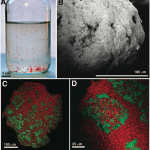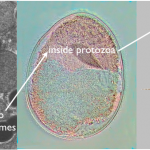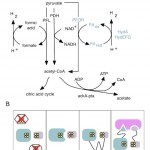bioenergy
One organism's trash is another organism's treasure. Our cellular wastes, carbon dioxide and water, nourish plants, which with added energy from sunlight produce the oxygen and sugars that we need to survive. At microscopic scales, these cycles of waste and food can get much more complicated, with many species of microbes working together to survive in harsh environments with limited nutrients.
When organisms (like us) digest sugars made of carbon (C), hydrogen (H), and oxygen (O), they split them up into carbon dioxide (CO2), hydrogen ions (H+) and high-energy electrons (e-) that were…
I had a great conversation with Maggie Koerth-Baker from BoingBoing for bloggingheads.tv Science Saturday. We talked about all sorts of sciency stuff, including her upcoming book on the challenges of renewable energy, synthetic biology, the similarities between cheese and the human body, women in science/blogging, and octopus brains. I had a lot of fun chatting with Maggie and I learned a lot, and I hope you will too!
There's a terrific new article in New Scientist about some of the ways scientists are working on turning pee into energy. There's a lot of pee in the world all going to waste, often at huge cost to the environment in terms of energy used to collect and purify waste water. Methods that can produce even small amounts of power from urine could be useful to help power office buildings or farms where there are a lot of people or animals all peeing in the same place, and smaller fuel cells could even also be used to power portable electronics, with no need to carry any fuel or batteries, just a…
Biosafety has been on everyone's mind this week after the announcement of the J. Craig Venter Institute's successful transplantation of a synthetic genome. What horrible pathogen will future bioengineers be able to design? What unforeseeable environmental catastrophe will befall us upon the release of genetically engineered bacteria? These are hugely important questions as research in synthetic biology moves forward, being discussed in congressional hearings and as an integral part of every new synthetic biology design.
As the major proposed goal of a great deal of synthetic biology research…
Many people in synthetic biology, including myself and much of my lab, are working on using biology to make things more efficiently, renewably, and sustainably. Being able to make plastic replacing biomaterials, chemicals, medicines, and fuels in living cells from renewable resources (especially in photosynthetic organisms that need only sunlight and water) will undoubtedly decrease our dependence on fossil fuels and with a lot of work in policy and process and infrastructure engineering may one day become truly sustainable. It's difficult to not notice, however, how unsustainable most…
My two great thesis project loves are hydrogen and symbiosis, and as such, the recent news of a multicellular organism that lives in a completely oxygen free environment and gets its energy from hydrogenosomes instead of mitochondria is totally fascinating.
Hydrogenosomes are organelles that are evolutionarily related to mitochondria. Mitochondria generate energy for the cell by transferring electrons pulled off of sugars molecules to oxygen (this is why we breathe oxygen). The energy from this electron motion is transferred to the production of ATP, the energy currency of the cell, through…
Because of my recent interest in autonomous, biologically inspired robots, my friend Tami sent me some fascinating links about designs and concepts for future flesh eating robots.
From New Scientist, furniture that captures vermin and uses the biomass to power fuel cells that run small electronics:
From Wired, Human corpse powered robots being developed by the Defense Department:
From the file marked "Evidently, many scientists have never seen even one scary sci-fi movie": The Defense Department is funding research into battlefield robots that power themselves by eating human corpses. What…
My paper, "Insulation of a synthetic hydrogen metabolism circuit in bacteria" just came out in the Journal of Biological Engineering! And it's open access!
We designed a metabolic circuit in bacteria that produces hydrogen (a potentially useful fuel) from natural precursors in the cell. The proteins in our synthetic pathway work to make hydrogen by transferring high-energy electrons from pyruvate, a common metabolite, to protons that are freely floating in the watery cytoplasm. The electrons transfer between the proteins through quantum-mechanical tunneling, which makes hydrogenases and…
Riversimple, a small UK-based company, has designed a tiny, relatively cheap, and remarkably open-source hydrogen fuel cell car. The car will not be available for sale, but people will be able to lease it, with the lease agreement including maintenance, fuel, and the eventual recycling of the car. This unique business model allows for the company to manage sustainability for the life of the car. Check out the video below to see the car in action:
Hydrogen, of course is still hard to make, and there aren't many sustainable hydrogen production options. My lab is working on ways to make…





